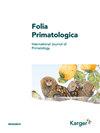Tool use by Nigeria-Cameroon chimpanzees for driver ant predation in Kom-Wum Forest Reserve, North-West Region Cameroon
IF 0.8
4区 生物学
Q2 ZOOLOGY
引用次数: 1
Abstract
Chimpanzees feed on driver ants (Dorylus sp.) using different tools and predation techniques that vary among populations and can be affected by availability of ant species as well as ecological and social-learning factors. At the Kom-Wum Forest Reserve (KWFR) in Cameroon, we investigated tool use behavior in Nigerian-Cameroon chimpanzees (Pan troglodytes ellioti), examining the characteristics of tools used in driver ant predation, looking for possible seasonal patterns and comparing our results to those from other study sites. We recovered 83 tools along line transects and recces (reconnaissance) during two seasons. We found that chimpanzees used tools with blunting and dirty ends (possible digging and probing tools) and tools without (dipping tools), in driver ant predation. Tools with dirty ends tended to be thicker (N = 52), and thinner tools were less likely to have dirt (N = 31). Tools recovered in the wet season (N = 62), were significantly shorter and thicker than those recovered in the dry season (N = 21). Furthermore, driver ant tools recovered at KWFR are on average the longest yet recorded insect dipping tools for chimpanzees comparable to those used in North Uele. We found no evidence of nut-cracking, tool use for honey bee nor termite consumption and did not observe the potential prey remains in chimpanzee faeces despite their presence in the reserve. Our results suggest that seasonality significantly contributes to a divergence in the form of tools selected for driver ant predation.尼日利亚-喀麦隆黑猩猩在喀麦隆西北地区Kom Wum森林保护区捕食驱动蚁的工具
黑猩猩以驱动蚂蚁(Dorylus sp.)为食,使用不同的工具和捕食技术,这些技术因种群而异,并可能受到蚂蚁种类的可用性以及生态和社会学习因素的影响。在喀麦隆的Kom-Wum森林保护区(KWFR),我们调查了尼日利亚-喀麦隆黑猩猩(Pan troglodytes ellioti)的工具使用行为,检查了驱动蚂蚁捕食时使用的工具的特征,寻找可能的季节模式,并将我们的结果与其他研究地点的结果进行了比较。在两个季节中,我们沿着线样线和侦察线回收了83个工具。我们发现,黑猩猩在捕食蚂蚁时,会使用末端钝且脏的工具(可能是挖掘和探测工具)和没有末端的工具(蘸料工具)。末端脏的工具往往较厚(N = 52),而较薄的工具不太可能有污垢(N = 31)。在雨季(N = 62)回收的工具明显比在旱季(N = 21)回收的工具更短、更厚。此外,在KWFR发现的驱动蚂蚁工具是迄今为止记录的最长的黑猩猩昆虫沾水工具,与北威勒使用的工具相当。我们没有发现坚果开裂、蜜蜂使用工具或白蚁食用的证据,也没有在黑猩猩的粪便中观察到潜在的猎物遗骸,尽管它们存在于保护区内。我们的研究结果表明,季节性在驱动蚂蚁选择捕食工具的形式上有显著的差异。
本文章由计算机程序翻译,如有差异,请以英文原文为准。
求助全文
约1分钟内获得全文
求助全文
来源期刊

Folia Primatologica
生物-动物学
CiteScore
3.30
自引率
10.50%
发文量
36
审稿时长
>12 weeks
期刊介绍:
Recognizing that research in human biology must be founded on a comparative knowledge of our closest relatives, this journal is the natural scientist''s ideal means of access to the best of current primate research. ''Folia Primatologica'' covers fields as diverse as molecular biology and social behaviour, and features articles on ecology, conservation, palaeontology, systematics and functional anatomy. In-depth articles and invited reviews are contributed by the world’s leading primatologists. In addition, special issues provide rapid peer-reviewed publication of conference proceedings. ''Folia Primatologica'' is one of the top-rated primatology publications and is acknowledged worldwide as a high-impact core journal for primatologists, zoologists and anthropologists.
 求助内容:
求助内容: 应助结果提醒方式:
应助结果提醒方式:


